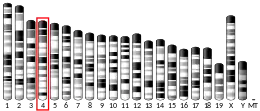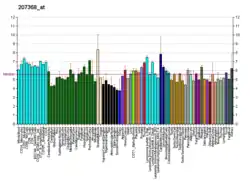5-HT1D receptor
5-hydroxytryptamine (serotonin) receptor 1D, also known as HTR1D, is a 5-HT receptor, but also denotes the human gene encoding it.[5] 5-HT1D acts on the central nervous system, and affects locomotion and anxiety. It also induces vascular vasoconstriction in the brain.
Tissue Distribution and Function
5HT1D receptors are found at low levels in the basal ganglia (globus pallidus, substantia nigra, caudate putamen), the hippocampus, and in the cortex.[6]
Structure
5HT1D receptor is a G protein linked receptor that activates an intracellular messenger cascade to produce an inhibitory response by decreasing cellular levels of cAMP.[7][8] The 5HT1D is a 7-TM receptor. A large intercellular loop between TM-5 and TM-6 is believed to be associated with coupling to a second messenger. Agonists might bind in a manner that utilizes an aspartate residue in TM-3 and residues in the TM-4, TM-5 and TM-6.[9] A human clone containing an intronless open reading frame was found to encode 377 amino acids of the 5HT1D receptor. The gene has been localized on chromosome 1, region 1p34.3-36.3 [10][11]
Ligands
Agonists
Molecular modelling has provided a picture of the agonistic binding site of 5HT1D. The amino acid residues within the receptor binding site region have been identified. This is a valuable guide to design potential 5HT1D receptor agonists. When sumatriptan binds there is major conformational change in both ligand and receptor in the binding pocket.[12]
- 5-(Nonyloxy)tryptamine[13]
- Sumatriptan (vasoconstrictor in migraine)
- 5-Carboxamidotryptamine (5-CT)
- 5-(t-Butyl)-N-methyltryptamine[14]
- CP-135,807
- CP-286,601
- PNU-109,291 ((S)-3,4-Dihydro-1-[2-[4-(4-methoxyphenyl)-1-piperazinyl]ethyl]-N-methyl-1H-2-benzopyran-6-carboxamide)
- PNU-142,633 ((1S)-1-[2-[4-[4-(Aminocarbonyl)phenyl]-1-piperazinyl]ethyl]-3,4-dihydro-N-methyl-1H-2-benzopyran-6-carboxamide)
- GR-46611 (3-[3-(2-Dimethylaminoethyl)-1H-indol-5-yl]-N-(4-methoxybenzyl)acrylamide)
- L-694,247 (2-[5-[3-(4-Methylsulfonylamino)benzyl-1,2,4-oxadiazol-5-yl]-1H-indol-3-yl]ethanamine)
- L-772,405
Antagonists
- Ziprasidone (atypical antipsychotic)
- Methiothepin (antipsychotic)
- Yohimbine (aphrodisiac)
- Metergoline
- Ergotamine (vasoconstrictor in migraine)
- BRL-15572
- Vortioxetine (antidepressant)
- GR-127,935 (mixed 5-HT1B/1D antagonist)
- LY-310,762
- LY-367,642
- LY-456,219
- LY-456,220
See also
References
- GRCh38: Ensembl release 89: ENSG00000179546 - Ensembl, May 2017
- GRCm38: Ensembl release 89: ENSMUSG00000070687 - Ensembl, May 2017
- "Human PubMed Reference:". National Center for Biotechnology Information, U.S. National Library of Medicine.
- "Mouse PubMed Reference:". National Center for Biotechnology Information, U.S. National Library of Medicine.
- "Entrez Gene: HTR1D 5-hydroxytryptamine (serotonin) receptor 1D".
- Hoyer, D., 2019. Serotonin receptors nomenclature. The Serotonin System, pp.63-93.
- Millan, M.J., et al., Signaling at G-protein-coupled serotonin receptors: recent advances and future research directions. Trends in Pharmacological Sciences, 2008. 29(9): p. 454-464.
- Goadsby, P.J., Serotonin 5-HT1B/1D receptor agonists in migraine - Comparative pharmacology and its therapeutic implications. Cns Drugs, 1998. 10(4): p. 271-286.
- Lippincott, W. W., Lemke, T. L., Williams, D. A., Roche, V. F., & Zito, S. W. (2013). Foye's Principles of Medicinal Chemistry: Lippincott Williams & Wilkins: 368-376.
- Jin, H.; Oksenberg, D.; Ashkenazi, A.; Peroutka, S. J.; Duncan, A. M.; Rozmahel, R.; O'Dowd, B. F. (1992). "Characterization of the human 5-hydroxytryptamine1B receptor". J Biol Chem. 267 (9): 5735–5738. PMID 1348246.
- Weinshank, R. L.; Zgombick, J. M.; Macchi, M. J.; Branchek, T. A.; Hartig, P. R. (1992). "Human Serotonin-1d Receptor Is Encoded by a Subfamily of 2 Distinct Genes - 5-Ht(1d-Alpha) and 5-Ht(1d-Beta)". Proceedings of the National Academy of Sciences of the United States of America. 89 (8): 3630–3634. doi:10.1073/pnas.89.8.3630. PMC 48922. PMID 1565658.
- Bremner, D. H.; Ringan, N. S.; Wishart, G. (1997). "Modeling of the agonist binding site of serotonin human 5-HT1A, 5-HT1Dα and 5-HT1Dβ receptors". European Journal of Medicinal Chemistry. 32 (1): 59–69. doi:10.1016/S0223-5234(97)84362-0.
- Glennon RA, Hong SS, Dukat M, Teitler M, Davis K (Sep 1994). "5-(Nonyloxy)tryptamine: a novel high-affinity 5-HT1D beta serotonin receptor agonist". Journal of Medicinal Chemistry. 37 (18): 2828–30. doi:10.1021/jm00044a001. PMID 8071931.
- Xu YC, Schaus JM, Walker C, Krushinski J, Adham N, Zgombick JM, Liang SX, Kohlman DT, Audia JE (Feb 1999). "N-Methyl-5-tert-butyltryptamine: A novel, highly potent 5-HT1D receptor agonist". Journal of Medicinal Chemistry. 42 (3): 526–31. doi:10.1021/jm9805945. PMID 9986723.
External links
- "5-HT1D". IUPHAR Database of Receptors and Ion Channels. International Union of Basic and Clinical Pharmacology.
- Human HTR1D genome location and HTR1D gene details page in the UCSC Genome Browser.
Further reading
- Hamblin MW, Metcalf MA, McGuffin RW, Karpells S (Apr 1992). "Molecular cloning and functional characterization of a human 5-HT1B serotonin receptor: a homologue of the rat 5-HT1B receptor with 5-HT1D-like pharmacological specificity". Biochemical and Biophysical Research Communications. 184 (2): 752–9. doi:10.1016/0006-291X(92)90654-4. PMID 1315531.
- Weinshank RL, Zgombick JM, Macchi MJ, Branchek TA, Hartig PR (Apr 1992). "Human serotonin 1D receptor is encoded by a subfamily of two distinct genes: 5-HT1D alpha and 5-HT1D beta". Proceedings of the National Academy of Sciences of the United States of America. 89 (8): 3630–4. doi:10.1073/pnas.89.8.3630. PMC 48922. PMID 1565658.
- Hamblin MW, Metcalf MA (Aug 1991). "Primary structure and functional characterization of a human 5-HT1D-type serotonin receptor". Molecular Pharmacology. 40 (2): 143–8. PMID 1652050.
- Libert F, Passage E, Parmentier M, Simons MJ, Vassart G, Mattei MG (Sep 1991). "Chromosomal mapping of A1 and A2 adenosine receptors, VIP receptor, and a new subtype of serotonin receptor". Genomics. 11 (1): 225–7. doi:10.1016/0888-7543(91)90125-X. PMID 1662665.
- Libert F, Parmentier M, Lefort A, Dinsart C, Van Sande J, Maenhaut C, Simons MJ, Dumont JE, Vassart G (May 1989). "Selective amplification and cloning of four new members of the G protein-coupled receptor family". Science. 244 (4904): 569–72. doi:10.1126/science.2541503. PMID 2541503.
- Cargill M, Altshuler D, Ireland J, Sklar P, Ardlie K, Patil N, Shaw N, Lane CR, Lim EP, Kalyanaraman N, Nemesh J, Ziaugra L, Friedland L, Rolfe A, Warrington J, Lipshutz R, Daley GQ, Lander ES (Jul 1999). "Characterization of single-nucleotide polymorphisms in coding regions of human genes". Nature Genetics. 22 (3): 231–8. doi:10.1038/10290. PMID 10391209. S2CID 195213008.
- Salim K, Fenton T, Bacha J, Urien-Rodriguez H, Bonnert T, Skynner HA, Watts E, Kerby J, Heald A, Beer M, McAllister G, Guest PC (May 2002). "Oligomerization of G-protein-coupled receptors shown by selective co-immunoprecipitation". The Journal of Biological Chemistry. 277 (18): 15482–5. doi:10.1074/jbc.M201539200. PMID 11854302.
- Bergen AW, van den Bree MB, Yeager M, Welch R, Ganjei JK, Haque K, Bacanu S, Berrettini WH, Grice DE, Goldman D, Bulik CM, Klump K, Fichter M, Halmi K, Kaplan A, Strober M, Treasure J, Woodside B, Kaye WH (Apr 2003). "Candidate genes for anorexia nervosa in the 1p33-36 linkage region: serotonin 1D and delta opioid receptor loci exhibit significant association to anorexia nervosa". Molecular Psychiatry. 8 (4): 397–406. doi:10.1038/sj.mp.4001318. PMID 12740597. S2CID 22413624.
- Li J, Zhang X, Wang Y, Zhou R, Zhang H, Yang L, Wang B, Faraone SV (Dec 2006). "The serotonin 5-HT1D receptor gene and attention-deficit hyperactivity disorder in Chinese Han subjects". American Journal of Medical Genetics Part B. 141B (8): 874–6. doi:10.1002/ajmg.b.30364. PMID 17099886. S2CID 36543598.
This article incorporates text from the United States National Library of Medicine, which is in the public domain.




